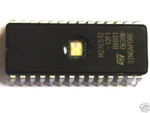Difference between revisions of "Read-only memory"
(Fixed some typos and inconsistencies, and updated the part about EEPROMS (they _can_ be updated in-circuit)) |
m (Typo fix: then -> than) |
||
| Line 1: | Line 1: | ||
ROM is simply Read Only Memory. | ROM is simply Read Only Memory. | ||
| − | Unlike [[RAM]] ROMs cannot be written to. ROMs are also typically slower | + | Unlike [[RAM]] ROMs cannot be written to. ROMs are also typically slower than RAM. |
ROMs come in several flavors: | ROMs come in several flavors: | ||
Revision as of 11:12, 10 February 2016
ROM is simply Read Only Memory.
Unlike RAM ROMs cannot be written to. ROMs are also typically slower than RAM.
ROMs come in several flavors:
PROM
PROMs can be programmed ONCE then read many times. If there are any mistakes in the PROM code, the entire chip must be discarded. While PROMs can be read in a normal board, they need to be programmed in a special device.
EPROM
EPROMs can be erased after they have been programmed. Normally there is a small window in the chip in which exposure to UV light will erase the EPROMs programming. EPROMs need to be programmed in a special programmer.
EEPROM
EEPROMS can be erased electronically, and reprogrammed through the application of higher than normal voltage. In modern EEPROMS this is generated internally. Unlike EPROMs EEPROMS can be rewritten in-circuit.
